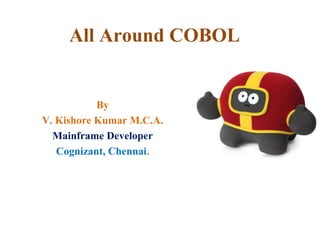
All around cobol
- 1. All Around COBOL By V. Kishore Kumar M.C.A. Mainframe Developer Cognizant, Chennai.
- 2. Is there Still market for COBOL skills/developers? • COBOL is dead right? • All the IT developer jobs now are in modern languages like C++, .Net & Java right?
- 3. Survey Report @ 2009 • 70-75% of the business and transaction systems around the world run on COBOL. This includes credit card systems, ATMs, ticket purchasing, retail/POS systems, banking, payroll systems, telephone/cell calls, grocery stores, hospital systems, government systems, airline systems, insurance systems, automotive systems, traffic signal systems.
- 4. Survey Report @ 2009 • 90% of global financial transactions are processed in COBOL. • The language supports over 30 billion transactions per day. • There are 1.5-2 million developers, globally, working with COBOL code. • There are around 200 billion lines of COBOL code in use.
- 5. Survey Report @ 2009 • Around 5 billion lines of new COBOL code are added to live systems every year. • The investment made into COBOL systems over the past 50 years is said to be worth about $2 trillion dollars.
- 6. COBOL • COmmon Business Oriented Language – 1959. • High Level Structured Language. • Can be used with database like VSAM, DB2 or IDMS. • Can handle huge volumes of data. • COBOL applications can be easily maintained.
- 8. Program Structure • Division is a block of code, usually containing one or more sections. – It starts where the division name is encountered. – It ends with the beginning of the next division. • A COBOL program has 4 divisions. Identification Division Environment Division Data Division Procedure Division
- 9. The COBOL Divisions • Identification Division : – Names the program. – Optionally, documents the date the program was written. – The compilation date and – Other pertinent information.
- 11. • Environment Division : – Machine Dependent details such as computer used and peripheral devices. – Consists of 2 sections • The Configuration Section • The Input-Output Section Environment Division
- 12. • Input-Output Section: – Primarily used to code the FILE-CONTROL paragraph. – Associate the files to be used in program with specific I/O devices. Environment Division
- 13. • All the data used by the program is defined. • It is divided into 5 sections – File Section – Working-storage Section – Linkage Section – Report Section and – Communication Section Data Division
- 14. • File Section : – Defines all the files that will be used in the program. – There will be one File Descriptor(FD) for each file followed by a record description for each record format. Data Division
- 15. • Working-Storage Section: – Used to define any data that will be used in program but not a part of file. • Linkage Section: – Used in a subprogram that will be passed as arguments to the routine. Data Division
- 16. • Consists of a series of procedures called paragraphs, each designed to perform a specific function. • All statements are terminated by a period(.). Procedure Division
- 17. Sample COBOL Program Layout
- 20. Picture Clause • Used to specify the type and size of an elementary data item.
- 21. Data Items – Level Numbers • Levels 01-49 are used to create hierarchical data items. • The highest level item in the hierarchy will always be the 01 item. • Items which contains other items are called Group Items. • Items which don’t contain other data items are called Elementary Items.
- 22. Data Items – Level Numbers
- 23. COBOL Statements • Display • Accept • Exit, STOP • MOVE • PERFORM • Arithmetic Statements
- 24. DISPLAY Statement • Exhibit data upon the primary output device.
- 25. ACCEPT Statement • Acquire data from the primary input device or various system fields.
- 26. EXIT & STOP Statement • Used to exit routines or programs. • EXIT Program must be used only in a called Sub-Program. • Used to STOP programs. • STOP RUN Terminates the program.
- 27. MOVE Statement • Used to copy data items to other data items.
- 28. PERFORM Statement • Used to execute the code.
- 29. PERFORM Statement • Code can be executed in another area of the program and is invoked by mentioning a procedure or paragraph name. • Inline Perform, code is executed inside the perform statement.
- 30. Arithmetic Statements • ADD • SUBTRACT • MULTIPLY • DIVIDE • COMPUTE
- 31. ADD SUBTRACT
- 32. MULTIPLY
- 33. DIVIDE
- 34. DIVIDE
- 35. COMPUTE
